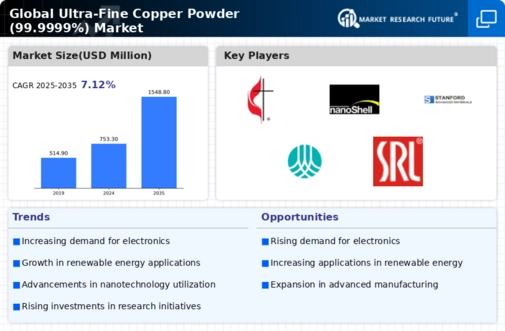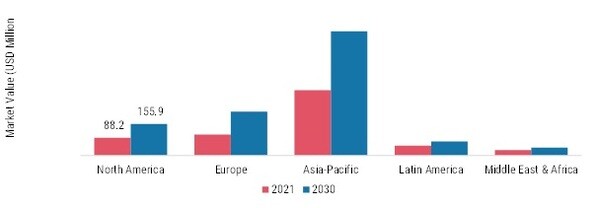-
Executive Summary
-
Scope of the Report
-
Market Definition
-
Scope of the Study
-
List of Assumptions
-
Markets Structure
-
Market Research Methodology
-
Research Process
-
Primary Research
-
Secondary Research
-
Market Size Estimation
-
Forecast Model
-
Market Factor Analysis
-
Supply Chain Analysis
- Raw Material Suppliers
- Manufacturers/Service Providers of Ultra-Fine Copper Powder (99.9999%)
- Distributors/Retailers/Wholesalers/E-Commerce Merchants
- End-Users
-
Porter’s Five Forces Model
- Threat of New Entrants
- Intensity of Competitive Rivalry
- Threat of Substitutes
- Bargaining Power of Suppliers
- Bargaining Power of Buyers
-
Pricing Analysis
-
Market Dynamics of Global Ultra-Fine Copper Powder (99.9999%) Market
-
Introduction
-
Drivers
-
Restraints
-
Opportunities
-
Challenges
-
Global Ultra-Fine Copper Powder (99.9999%) Market, by Type
-
Introduction
-
Nano Copper Particles Powder
- Market Estimates & Forecast, 2019–2030
- Market Estimates & Forecast, by Region, 2019–2030
-
Micro Copper Particles Powder
- Market Estimates & Forecast, 2019–2030
- Market Estimates & Forecast, by Region, 2019–2030
-
Global Ultra-Fine Copper Powder (99.9999%) Market, by Application
-
Introduction
-
Electrical & Electronics
- Market Estimates & Forecast, 2019–2030
- Market Estimates & Forecast, by Region, 2019–2030
-
Chemicals
- Market Estimates & Forecast, 2019–2030
- Market Estimates & Forecast, by Region, 2019–2030
-
Pharmaceuticals
- Market Estimates & Forecast, 2019–2030
- Market Estimates & Forecast, by Region, 2019–2030
-
Others
- Market Estimates & Forecast, 2019–2030
- Market Estimates & Forecast, by Region, 2019–2030
-
Global Ultra-Fine Copper Powder (99.9999%) Market, by Region
-
Introduction
-
North America
- Market Estimates & Forecast, 2019–2030
- Market Estimates & Forecast, by Type, 2019–2030
- Market Estimates & Forecast, by Application, 2019–2030
- US
- Canada
-
Europe
- Market Estimates & Forecast, 2019–2030
- Market Estimates & Forecast, by Type, 2019–2030
- Market Estimates & Forecast, by Application, 2019–2030
- Germany
- France
- Italy
- Spain
- UK
- Russia
- Poland
- Rest of Europe
-
Asia-Pacific
- China
- India
- South Korea
- Japan
- Rest of Asia-Pacific
-
Latin America
- Brazil
- Mexico
- Argentina
- Rest of Latin America
-
Middle East & Africa
- Saudi Africa
- GCC Countries
- Rest of the Middle East & Africa
-
Competitive Landscape
-
Introduction
-
Market Key Strategies
-
Competitive Benchmarking
-
Key Development Analysis (Expansions/Mergers & Acquisitions/Joint Ventures/New Ultra-Fine Copper Powder (99.9999%) Developments/Agreements/Investments)
-
Company Profiles
-
GGP METALPOWDER AG
- Company Overview
- Financial Overview
- Products Offered
- Key Developments
- SWOT Analysis
- Key Strategies
-
Mitsui Mining & Smelting Co., Ltd.
-
Umcor
-
Blockchain Mercantile Corporation
-
Cnpc Powder
-
Nanoshell Llc
-
American Elements
-
Pometon Powder
-
Stanford Advanced Materials
-
Tekna.
-
Nanografi Nano Technology
-
Sisco Research Laboratories Pvt. Ltd.
-
Appendix
-
-
LIST OF TABLES
-
Table 1: Global Ultra-Fine Copper Powder (99.9999%) Market, by region, 2019–2030
-
Table 2: North America: Ultra-Fine Copper Powder (99.9999%) Market, by Country, 2019–2030
-
Table 3: Europe: Ultra-Fine Copper Powder (99.9999%) Market, by Country, 2019–2030
-
Table 4: Asia-Pacific: Ultra-Fine Copper Powder (99.9999%) Market, by Country, 2019–2030
-
Table 5: Middle East & Africa: Ultra-Fine Copper Powder (99.9999%) Market, by Country, 2019–2030
-
Table 6: Latin America: Ultra-Fine Copper Powder (99.9999%) Market, by Country, 2019–2030
-
Table 13: Global Ultra-Fine Copper Powder (99.9999%) Type Market, by Region, 2019–2030
-
Table 14: North America: Ultra-Fine Copper Powder (99.9999%) Type Market, by Country, 2019–2030
-
Table 15: Europe: Ultra-Fine Copper Powder (99.9999%) Type Market, by Country, 2019–2030
-
Table 16: Asia-Pacific: Ultra-Fine Copper Powder (99.9999%) Type Market, by Country, 2019–2030
-
Table 17: Middle East & Africa: Ultra-Fine Copper Powder (99.9999%) Type Market, by Country, 2019–2030
-
Table 18: Latin America: Ultra-Fine Copper Powder (99.9999%) Type Market, by Country, 2019–2030
-
Table 19: Global Ultra-Fine Copper Powder (99.9999%) Type Market, by Region, 2019–2030
-
Table 20: North America: Ultra-Fine Copper Powder (99.9999%) Type Market, by Country, 2019–2030
-
Table 21: Europe: Ultra-Fine Copper Powder (99.9999%) Type Market, by Country, 2019–2030
-
Table 22: Asia-Pacific: Ultra-Fine Copper Powder (99.9999%) Type Market, by Country, 2019–2030
-
Table 23: Middle East & Africa: Ultra-Fine Copper Powder (99.9999%) Type Market, by Country, 2019–2030
-
Table 24: Latin America: Ultra-Fine Copper Powder (99.9999%) Type Market, by Country, 2019–2030
-
Table 25: Global Ultra-Fine Copper Powder (99.9999%) Type Market, by Region, 2019–2030
-
Table 26: Global Ultra-Fine Copper Powder (99.9999%) Type Market, by Region, 2019–2030
-
Table 27: North America: Ultra-Fine Copper Powder (99.9999%) Market, by Country, 2019–2030
-
Table 29: North America: Ultra-Fine Copper Powder (99.9999%) Market, by Type, 2019–2030
-
Table 30: North America: Ultra-Fine Copper Powder (99.9999%) Market, by Application, 2019–2030
-
Table 31: Europe: Ultra-Fine Copper Powder (99.9999%) Market, by Country, 2019–2030
-
Table 32: Europe: Ultra-Fine Copper Powder (99.9999%) Market, by Type, 2019–2030
-
Table 33: Europe: Ultra-Fine Copper Powder (99.9999%) Market, by Application, 2019–2030
-
Table 34: Asia-Pacific: Ultra-Fine Copper Powder (99.9999%) Market, by Country, 2019–2030
-
Table 35: Asia-Pacific: Ultra-Fine Copper Powder (99.9999%) Market, by Type, 2019–2030
-
Table 36: Asia-Pacific: Ultra-Fine Copper Powder (99.9999%) Market, by Application, 2019–2030
-
Table 37: Middle East & Africa: Ultra-Fine Copper Powder (99.9999%) Market, by Country, 2019–2030
-
Table 38: Middle East & Africa: Ultra-Fine Copper Powder (99.9999%) Market, by Type, 2019–2030
-
Table 39: Middle East & Africa: Ultra-Fine Copper Powder (99.9999%) Market, by Application, 2019–2030
-
Table 40: Latin America: Ultra-Fine Copper Powder (99.9999%) Market, by Country, 2019–2030
-
Table 41: Latin America: Ultra-Fine Copper Powder (99.9999%) Market, by Type, 2019–2030
-
Table 42: Latin America: Ultra-Fine Copper Powder (99.9999%) Market, by Application, 2019–2030
-
LIST OF FIGURES
-
Global Ultra-Fine Copper Powder (99.9999%) Market Segmentation
-
Forecast Research Methodology
-
Porter’s Five Forces Analysis of Global Ultra-Fine Copper Powder (99.9999%) Market
-
Value Chain/Supply Chain of Global Ultra-Fine Copper Powder (99.9999%) Market
-
Share of Global Ultra-Fine Copper Powder (99.9999%) Market, by Country, 2021 (%)
-
Global Ultra-Fine Copper Powder (99.9999%) Market, 2019–2030
-
Global Ultra-Fine Copper Powder (99.9999%) Market Size, by Type, 2019–2030
-
Share of Global Ultra-Fine Copper Powder (99.9999%) Market, by Type, 2020 (%)
-
Global Ultra-Fine Copper Powder (99.9999%) Market Size, by Application, 2019–2030
-
Share of Global Ultra-Fine Copper Powder (99.9999%) Market, by Application, 2021 (%)'









Leave a Comment